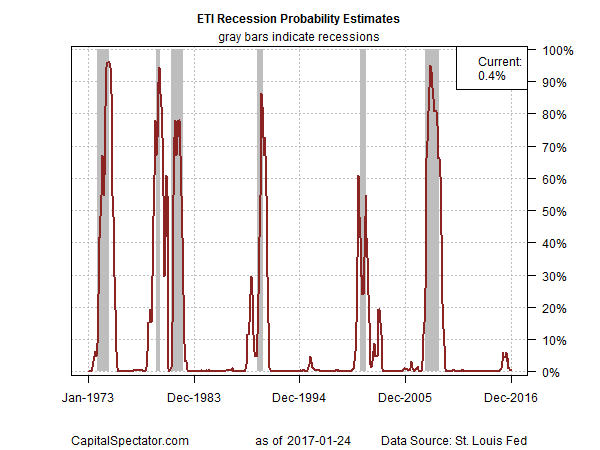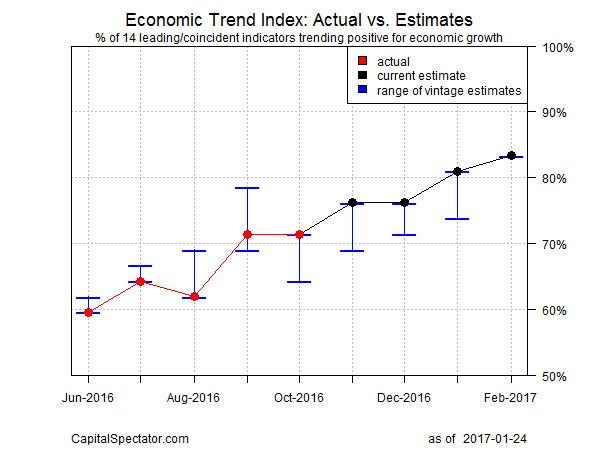Economic growth kept recession risk low in the final month of 2016. After wobbly readings in the first half of last year, the macro trend has strengthened in recent months and near-term projections point to a modest acceleration in this year’s first quarter.
Data published to date clearly show that December’s economic profile is unlikely to mark the beginning of a new recession, as defined by NBER, the arbiter of US business cycle peaks and troughs. Recent estimates of fourth-quarter GDP growth support the low-recession-risk analysis. Although most analysts and models are expecting a slower pace of growth in Q4 vs. the previous quarter, forward momentum in the broad economy is widely projected to roll on. Econoday.com’s consensus forecast anticipates a 2.2% increase in the Q4 GDP report that’s due on Friday–down from 3.5% in Q3, but still solidly in the growth column.
Meanwhile, the Capital Spectator’s proprietary business-cycle indexes continue to reflect a low probability that a downturn has started. As projected (see bottom chart here, for instance), US economic activity has strengthened after a slowdown in the first half of 2016. Although some components in the benchmarks still reflect weakness (see table below), the broad trend has rebounded in recent months and current projections (see last chart below) still point to modestly faster growth in the first quarter. (For a more comprehensive read on business-cycle analysis on a weekly basis, see The US Business Cycle Risk Report.)
Aggregating the data in the table above continues to reflect a broad trend that remains solidly positive. The Economic Trend and Momentum indices (ETI and EMI, respectively) were steady in December, holding on to gains posted in previous months. As a result, both benchmarks remain moderately above their respective danger zones: 50% for ETI and 0% for EMI. When/if the indexes fall below those tipping points, we’ll have clear warning signs that recession risk is at a critical level, in which case a new downturn is likely. The analysis is based on a methodology outlined in my book on monitoring the business cycle.
Translating ETI’s historical values into recession-risk probabilities via a probit model also points to low business-cycle risk for the US through last month. Analyzing the data with this methodology shows that the numbers continue to imply that the odds are virtually nil that NBER will declare December as the start of a new recession.
For perspective on looking ahead, consider how ETI may evolve as new data is published. One way to project future values for this index is with an econometric technique known as an autoregressive integrated moving average (ARIMA) model, based on calculations via the “forecast” package for R. The ARIMA model calculates the missing data points for each indicator and for each month — in this case through February 2017. (Note that October 2016 is currently the latest month with a full set of published data.) Based on today’s projections, ETI is expected to trend higher and remain well above its danger zone for the near term by holding above the 50% mark.
Forecasts are always suspect, of course, but recent projections of ETI for the near-term future have proven to be relatively reliable guesstimates vs. the full set of published numbers that followed. That’s not surprising, given ETI’s design to capture the broad trend based on multiple indicators. Predicting individual components, by contrast, is prone to far more uncertainty. The assumption here is that while any one forecast for a given indicator will likely be wrong, the errors may cancel out to some degree by aggregating a broad set of predictions. That’s a reasonable view according to the generally accurate historical record for the ETI forecasts.
The current projections (the four black dots in the chart above) suggest that the economy will continue to expand. If fact, the projections through next month show a degree of acceleration in the broad trend. The chart above also includes the range of vintage ETI projections published on these pages in previous months (blue bars), which you can compare with the actual data (red dots) that followed, based on current numbers.
For additional perspective on judging the track record of the forecasts, here are the previous updates for the last three months:
20 Dec 2016
18 Nov 2016
20 Oct 2016
Note: ETI is a diffusion index (i.e., an index that tracks the proportion of components with positive values) for the 14 leading/coincident indicators listed in the table above. ETI values reflect the 3-month average of the transformation rules defined in the table. EMI measures the same set of indicators/transformation rules based on the 3-month average of the median monthly percentage change for the 14 indicators. For purposes of filling in the missing data points in recent history and projecting ETI and EMI values, the missing data points are estimated with an ARIMA model.




Pingback: Recession Risk Low in December - TradingGods.net